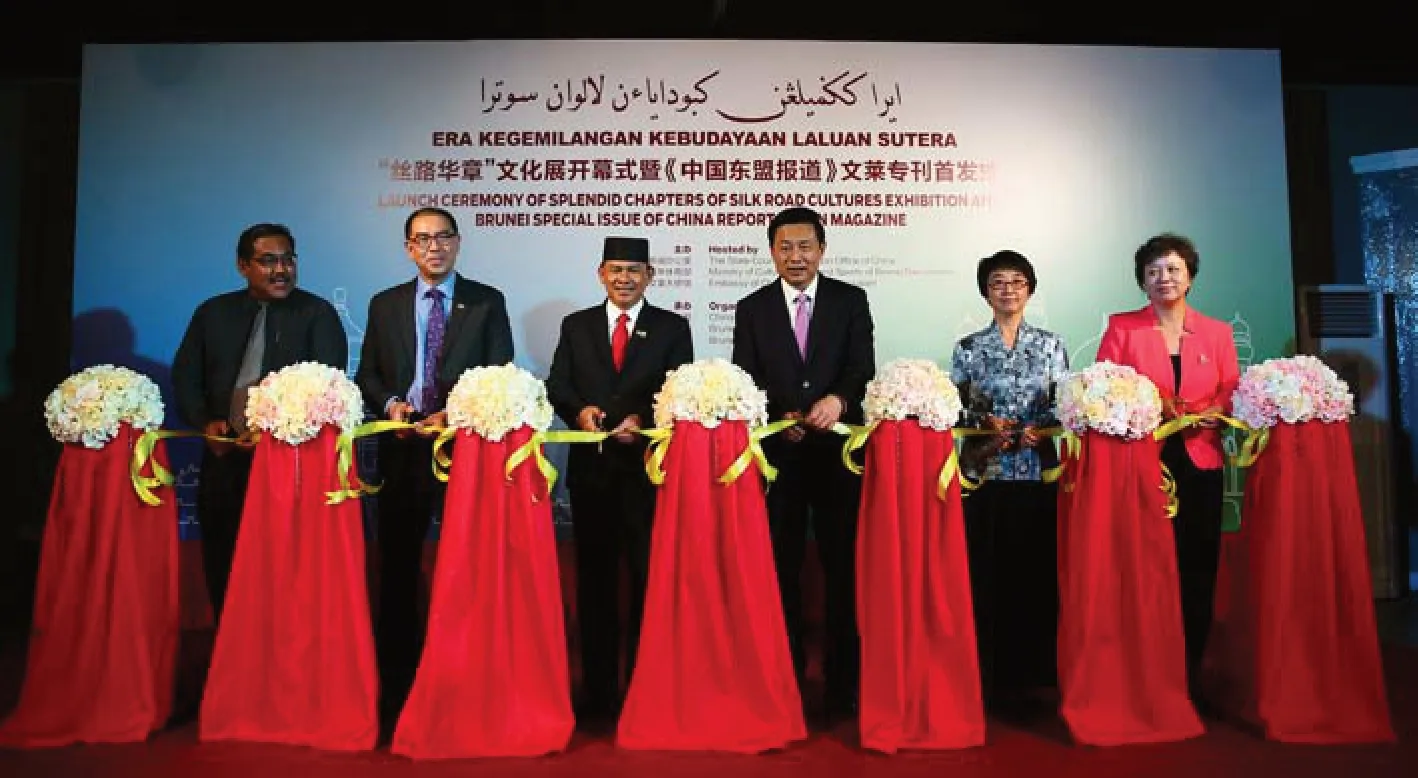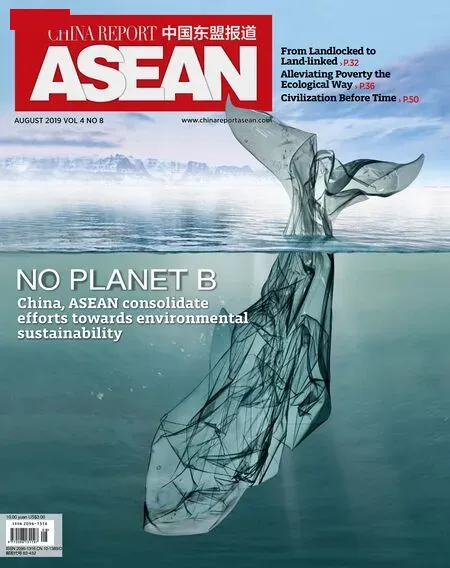OUTSTRETCHED HANDS Firdaus Rahman has been long dedicated to promoting people-to-people exchange and cooperation between China and ASEAN countries
By Wang Fengjuan
Firdaus Rahman clearly remembers his early 1990s visit to Guangzhou for the prestigious China Import and Export Fair (Canton Fair). As a business representative from the Chinese Chamber of Commerce of Bandar Seri Begawan (CCC BSB) attending arguably the only channel of international trade for Chinese enterprises back then, Rahman marveled at the kinetic and rapid economic and social development of Guangzhou, capital of southern China's Guangdong Province, even though it still lagged behind Brunei. “In those days, ATMs were still like space-age gadget in China,” he recalls. “Many people were awed by the ATM we exhibited.”
Over the years, Rahman has continued shuttling between China and Brunei, witnessing the dramatic changes taking place in both countries. “You can feel how modern China has become if you're a dinosaur still paying with cash,” he grins. “China is clearly ahead of Brunei in mobile payments.”
“While expanding international trade with countries around the world, China is placing increasing attention on exchange and mutual learning with other civilizations, a shift evidenced by the recent success of the Conference on Dialogue of Asian Civilizations,” Rahman remarked in an interview to China Report ASEAN.
‘My Dream' a Hit in Brunei
During his tenure as secretarygeneral of CCC BSB, Rahman established close relationships with Chinese governments and companies. Gradually, he realized that institutional cultural exchange is important to deepening mutual understanding between peoples, which inspired him to embark on a journey of promoting cultural exchange between China and Brunei.
In 2004, thanks to a recommendation from the Chinese Embassy in Brunei, Rahman watched “My Dream,” a thematic performance by the China Disabled People's Performing Art Troupe (CDPPAT). “I was so touched by the performers' enticing interpretation of dreams with confidence and beauty that I decided to exhort more people in Brunei to see the show,” he explains. He started actively preparing a show by securing venues, scheduling, processing visa application and providing accommodations for the CDPPAT artists. The local Brunei government also rendered great support.
On the evening of February 27, 2004, Jerudong Park Amphitheatre in Bandar Seri Begawan was packed. Accompanied by the melodious pipa (traditional Chinese plucked instrument), more than a dozen dancers led by Tai Lihua, who currently serves as president of CDPPAT, presented the dance “Thousand-hand Avalokitesvara Bodhisattva” to kick off the show. Dressed in gorgeous costumes, the dancers employed graceful steps to create an awe-inspiring visual impact while highlighting the charm of Buddhist art, prompting waves of applause from spectators.

Muhd Firdaus Bin Abdul Rahman, president of the Brunei-China Friendship Association.
Brunei cultural elements were also incorporated into the program. When visually impaired singer Yang Haitao greeted the audience in Malay, a roar of cheers erupted. His performance of the song “Fate of the Blind” moved many to tears.
When the curtain dropped, the amphitheatre resounded with applause and cheers, and spectators were reluctant to leave. Queen Saleha
"We should look at Asian development and building a community of shared future for mankind with a far-sighted vision.”of Brunei ascended the stage to shake hands with the Chinese performers, repeatedly thanking them heartily.

Vice Minister of the State Council Information Office of China Guo Weimin (third right), Minister of Culture, Youth and Sports of Brunei Darussalam Major General (Rtd) Dato Paduka Seri Awang Haji Aminuddin Ihsan bin Pehin Orang Kaya Saiful Mulok Dato Seri Paduka Haji Abidin (third left), Chinese Ambassador to Brunei Darussalam Yang Jian (second right), Deputy Editor-in-Chief of China International Publishing Group Chen Shi (first right), Acting Director of Brunei Museums Department Awang Haji Mohamad Jefri bin Haji Sabli (first left) and President of the Brunei-China Friendship Association Muhammad Firdaus Bin Abdul Rahman (second left) cut the ribbon for the launch ceremony of the “Splendid Chapters of Silk Road Cultures” exhibition and the Brunei Special Issue of China Report ASEAN held in Bandar Seri Begawan, Brunei Darussalam, on November 15, 2018.
According to Rahman, only Michael Jackson and Hong Kong singer Jacky Cheung had been able to sell out the 4,000-seat Jerudong Park Amphitheatre—never had it been so packed for an art troupe. CDPPAT artists made history. Chinese Ambassador to Brunei Wei Wei at the time revealed that he once received more than 70 calls in a single day asking for assistance with tickets to the show.
Building People-to-People Bonds
The year 2005 brought a shift of the focus of work for Firdaus Rahman. A year earlier, the Brunei Sultan's China visit prompted the founding of the China-Brunei Friendship Association in China. To establish a Bruneian counterpart, Rahman invited Jamaluddin to co-found the Brunei-China Friendship Association (BCFA) to pool the resources of Bruneian figures with expertise and ties to China. Rahman became the organization's secretary-general.
In 2007, with the help of the Chinese People's Association for Friendship with Foreign Countries and the China-ASEAN Association (CAA), BCFA sponsored the Second Conference on ASEAN-China Peopleto-People Friendship Organizations (CACPPFO) in Brunei, the first time the event was hosted by an ASEAN country. “Though BCFA was still young at the time, Brunei was the first ASEAN member state alphabetically, so we couldn't refuse,” Rahman grins. Their inaugural hosting proved successful thanks to support from many different circles. Incorporation of the elements of Fuwa, the five doll mascots from the 2008 Olympic Games, was particularly popular with delegates from ASEAN countries and local citizens alike.
CAA President Gu Xiulian once remarked that 2007 marked the 40th anniversary of the founding of ASEAN and that the second CACPPFO was undoubtedly a celebratory event significant to promoting the China-ASEAN strategic partnership, enhancing people-to-people dialogue and cooperation between the two sides and increasing mutual understanding. When addressing the opening ceremony of the event, Princess Hajah Masna, ambassadorat-large of the Ministry of Foreign Affairs and Trade of Brunei, noted that relations between ASEAN and China have developed rapidly, and opined that expanding bilateral cooperation would further promote regional peace and prosperity.
In 2014 to celebrate the ASEANChina Year of Cultural Exchange, Rahman organized the “Charming ASEAN · Approaching China” Cultural Tour and invited participation from cultural institutions in every ASEAN country. Major Chinese cities such as Beijing, Shanghai, Guangzhou, Nanning and Kunming enthusiastically host cultural activities, so Rahman decided that the cultures of ASEAN countries were best promoted in China in a downto-earth manner. Fangchenggang, a port city in southwestern China's Guangxi Zhuang Autonomous Region, became the first leg of the cultural tour, a plan well received by leaders of the municipal government of Fangchenggang.
The 2019 Conference on Dialogue of Asian Civilizations left a deep impression on Rahman. “Cultural exchange can strengthen peopleto-people bonds, and this is a key concept related to the Belt and Road Initiative and the building of a community of shared future for mankind,” he remarks. He believes that through the carnival, exhibitions and forums, the Conference boosted cultural awareness, mutual trust and interaction among Asian civilizations—and that such awareness and mutual trust would spill over into other areas.
“Just as decades ago when the world started trading with China through Guangzhou, we should look at Asian development and building a community of shared future for mankind with a far-sighted vision,” stresses Rahman. “Brunei is a small economy, but it will leave no stone unturned to promote regional economic prosperity and safeguard world peace and development.”
- China Report Asean的其它文章
- CHINESE, VIETNAMESE COMMUNIST PARTIES HOLD 15TH THEORY SEMINAR
- SEIZING SUSTAINABLE SOLUTIONS CHINA SETS THE STANDARD FOR ALLEVIATING POVERTY AND PROMOTING ONGOING GROWTH
- CHINESE VP MEETS MALAYSIAN DEPUTY PM
- 2019 CHINAASEAN EDUCATION COOPERATION WEEK
- NO PLANET B
- LI: MORE OPEN, TRANSPARENT, PREDICTABLE CHINA FOR FOREIGN INVESTMENT

